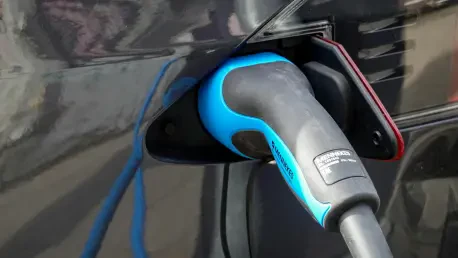As electric vehicles (EVs) continue to gain traction as a cornerstone of sustainable transportation, a surprising concern has emerged about the infrastructure supporting them, particularly in densely populated areas like Los Angeles County. Recent research conducted across numerous fast charging stations in this region of California has uncovered an unexpected environmental challenge: elevated levels of fine particulate matter, known as PM2.5, in the immediate vicinity of these hubs. This microscopic air pollution, linked to serious health risks, raises questions about whether the very technology designed to reduce emissions might inadvertently contribute to localized air quality issues. Far from being a mere byproduct of urban settings, the findings point to a specific hardware-related factor at play. This discovery challenges long-held assumptions about the cleanliness of EV infrastructure and prompts a deeper look into how these stations operate and their impact on the surrounding environment.
Uncovering the Hidden Impact of EV Chargers
Identifying Elevated Pollution Levels
A comprehensive study spanning 50 DC fast charging stations across 47 cities in Los Angeles County has revealed startling data about air quality near these facilities. Daily PM2.5 concentrations at these locations ranged from 7.3 to 39.0 micrograms per cubic meter, a stark contrast to the 3.6 to 12.4 micrograms per cubic meter observed at urban sites without chargers and nearby Environmental Protection Agency monitoring stations. This significant disparity suggests that the issue is not solely attributable to the stations’ proximity to busy roads or densely populated areas. Instead, it indicates a localized source of pollution directly tied to the charging infrastructure itself. The health implications of PM2.5, which can penetrate deep into the lungs and even enter the bloodstream, are well-documented, making this finding particularly concerning for those who frequent these stations, including EV drivers and nearby residents.
Pinpointing the Source of Particle Emissions
Delving deeper into the cause of these elevated pollution levels, the research points to an unexpected culprit within the charging stations’ hardware. The cooling fans in the power supply cabinets, essential for preventing overheating during the conversion of grid electricity to direct current for EV batteries, appear to play a critical role. According to the study, these fans can stir up internal dust and debris, a process known as particle resuspension, releasing it into the surrounding air. This mechanism differs from typical pollution sources, as the chargers themselves do not emit PM2.5 directly but rather redistribute existing particles. Such findings highlight a design oversight that could undermine the environmental benefits of EVs if left unaddressed. Understanding this hardware-related issue is crucial for developing targeted solutions to mitigate the impact on air quality near charging hubs.
Addressing the Localized Air Quality Challenge
Assessing the Scope of Exposure Risks
While the pollution from fast charging stations is a cause for concern, the study emphasizes that its impact is highly localized. Measurements taken directly at the power cabinets showed significantly higher PM2.5 levels, but these concentrations dropped sharply just a few meters away, becoming indistinguishable from background levels at a distance of a few hundred meters. Despite this limited range, the risk remains notable for EV drivers who may spend extended periods at charging stations, especially during peak times or slower charging sessions. Prolonged exposure to elevated PM2.5 levels could pose health risks, particularly for vulnerable populations such as children or the elderly who might be nearby. This localized nature of the pollution underscores the need for protective measures specifically tailored to those in close proximity to the chargers rather than broad, area-wide interventions.
Proposing Practical Solutions for Mitigation
In response to these findings, the research offers actionable recommendations to curb the unintended air quality impact of fast charging stations. One key suggestion is for manufacturers to install filters at the air inlets and outlets of power cabinets to trap dust before it enters or is released back into the environment. Additionally, strategic placement of chargers away from sensitive locations like schools, nursing homes, or densely populated areas could minimize public exposure to potential pollutants. These solutions reflect a consensus on the importance of design improvements to balance the benefits of EV infrastructure with public health considerations. By implementing such changes, the industry can address this manageable issue without compromising the critical role of fast chargers in supporting the transition to electric mobility. Reflecting on the past, stakeholders took initial steps to recognize this challenge, setting the stage for future innovations and safer operations in the years that followed.









